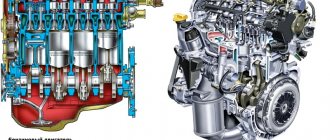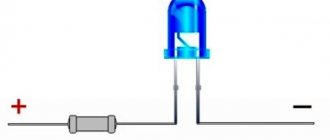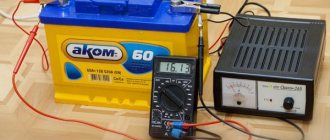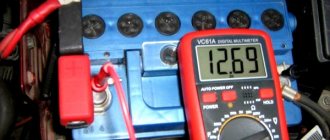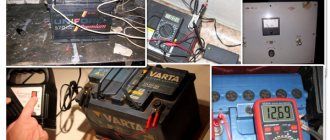From my personal experience, I was convinced how difficult the process of selecting sockets and plugs for household electrical appliances is, not to mention the selection of electrical wiring, switches and automatic machines. An ordinary user who has no idea about electricity can easily make a mistake with dire consequences.
To eliminate the possibility of errors, you need to either study this issue, as I did, or use tables with data.
I’ll start from the very beginning, namely why you need to find out how much power there is in kilowatts in amperes. And this is necessary because on sockets, plugs, fuses and other electrical wiring elements they write symbols in amperes, showing how much current this element can withstand, and in mechanisms they indicate the power in watts or kilowatts, thereby forcing people to independently calculate which device to use. which electrical wiring is suitable, and vice versa.
To make it clearer, to connect a 100 W light bulb you need one circuit breaker, but to connect an electric stove you need a completely different circuit breaker, like all other elements (electric cable, socket, plug, fuse, etc.), this is the difference.
To compare power in watts and current in amperes, you need to convert the values from one to the other.
For alternating voltage, calculations are quite simple; you just need to use the conversion formula, where in addition to current and power, voltage is also added.
This calculation formula is only suitable for a single-phase network
Wherein:
- A is Amps
- W is Watts
- V is for Volts
Example 1 is the simplest, let’s say your network voltage is 220 Volts, and the device is 220 Watts, which means to find amperes you need to divide 220 Watts by 220 Volts, we get 1 Ampere.
Example 2 is more complex, let’s say the mains voltage is 220 Volts, and you have a 600 Watt coffee grinder, which means 600 Watts must be divided by 220 Volts, we get 2.73 Amperes. This means that the coffee grinder needs to be wired at least 3 Amperes.
Example 3 condition of the question, we know that we have 1 Ampere and there are 220 Volts, we need to find how many kilowatts it is, which means we need to multiply 1 Watt by 220 Volts, we get 220 Watts.
To convert Watt to kiloWatt, you need to divide by 1000, we get that 220/1000 = 0.22 kW.
So the answer to your question is:
How many watts are in 1 ampere?
Now let's try to convert Watts to Amps.
And for this we need one more formula: In it, I is A, P is Watt, and U is Volt.
By making a simple calculation using this formula, we can find out how many Watts are in one A.
As we said earlier, there is another way to calculate how many watts are in 1 A. In order to use it, you will need to open an online calculator
and enter the power consumption as well as the voltage into it.
Next, you just need to click on the button labeled “calculate” and within a couple of seconds a special program will give you the correct value. By using this method, you will undoubtedly be able to save your time and effort, since you do not have to independently calculate all the indicators using formulas.
1 Volt is equal to the electrical voltage that causes a direct current of 1 ampere at a power of 1 watt in an electrical circuit.
Volt
(symbol:
V
,
V
) is a unit of measurement of electrical voltage in the SI system.
1 Volt is equal to the electrical voltage that causes a direct current of 1 ampere at a power of 1 watt in an electrical circuit.
Volt (V, V) can be defined either as the electrical voltage at the ends of a conductor required to generate one watt (W, W) of heat in it when a direct current of one ampere (A) flows through that conductor, or as the difference potentials between two points of the electrostatic field, when passing over a charge of 1 coulomb (C, C), work of 1 joule (J, J) is performed. Expressed in SI base units, one volt is equal to m2 kg s −3 A −1.
\
The unit is named after the Italian physicist and physiologist Alessandro Volta.
By this method, the value of a volt is unambiguously associated with the frequency standard set by a cesium clock: when a matrix consisting of several thousand Josephson junctions is irradiated with microwave radiation at frequencies from 10 to 80 GHz, a well-defined electrical voltage arises, with the help of which voltmeters are calibrated. Experiments have shown that this method is insensitive to the specific implementation of the installation and does not require the introduction of correction factors.
1 V = 1/300 units. SGSE potential.
What is Volt. Definition
A volt is defined as the potential difference across the ends of a conductor that dissipates one watt of power when the current through that conductor is one ampere.
From here, based on SI units, we get m² kg s-3 A-1, which is equivalent to joule of energy per coulomb of charge, J/C.
Definition based on the Josephson effect
The voltage of an electric current is a value that characterizes the difference in charges (potentials) between the poles or sections of the circuit through which the current flows.
Since 1990, the volt has been standardized by measurement using the time-dependent Josephson effect, which uses the Josephson constant as a reference to the standard, fixed by the 18th General Conference on Weights and Measurement as:
K{J-90} = 0.4835979 GHz/μV.
Multiples and submultiples
Decimal multiples and submultiples are formed using standard SI prefixes.
In accordance with the SI rules concerning derived units named after scientists, the name of the unit volt is written with a lowercase letter, and its designation is written with a capital letter. This spelling of the designation is also preserved in the designations of derived units formed using the volt. For example, the designation of the unit of measurement of electric field strength “volt per meter” is written as V/m.
Voltage scale
- The potential difference across the neuron membrane is 70 mV.
- NiCd battery - 1.2 V.
- Alkaline cell - 1.5 V.
- Lithium iron phosphate battery (LiFePO 4) - 3.3 V.
- Battery "Krona" - 9 V.
- Car battery - 12 V (for heavy trucks - 24 V).
- Household voltage is 220 V (rms).
- The voltage in the contact network of a tram and trolleybus is 600 V.
- Electrified railways - 3 kV (direct current), 25 kV (alternating current).
- Main power lines - 110 kV, 220 kV.
- The maximum voltage on power lines (Ekibastuz-Kokchetav) is 1.15 MV.
- The highest DC voltage obtained in the laboratory using a pelletron is 25 MV.
- Lightning - from 100 MV and above.
Javascript is disabled in your browser. To perform calculations, you must enable ActiveX controls!
Why do you need current calculation?
Let's count lighting together!
To calculate amperes by power for AC networks with reactive loads, appropriate corrections are needed. Such consumers shift the current vector by 90° forward (backward) with respect to the voltage with capacitive (inductive) characteristics, respectively.
Current calculation for a single-phase network
The change in current, voltage and power according to a sinusoidal graph explains the meaninglessness of measuring instantaneous values. The parameters are calculated taking into account time intervals. As a rule, the full period of one oscillatory cycle is used.
Current, voltage and power in a single-phase network with the connection of active, inductive, capacitive reactance
A generator with a significant value of the reactive component will perform its functions less efficiently. In this case, part of the power will not perform useful work.
Current calculation for a three-phase network
This option can be represented as a combination of several single-phase networks. When represented by vectors on the complex plane, a phase shift of 120° will be visible.
Three-phase network
The figures show a voltage of 220 V in each phase and a linear value of 380 V. You should pay attention to the current in the neutral conductor (I0), which does not perform useful functions. It is created due to the uneven distribution of connected loads.
How to calculate current power
To correct inductive (capacitive) components, an extended calculation formula is used:
P = I*cos ϕ.
In the absence of such loads, an additional factor is taken equal to one.
This ampere table will help you select the appropriate circuit breaker (fuse) taking into account the parameters of the connected equipment.
Dependence of current on power consumption
| Rated current of the protective device, A | Power consumption (kW) for the network | |
| Single phase | Three phases | |
| 2 | 0,4 | 1,3 |
| 6 | 1,3 | 3,9 |
| 16 | 3,5 | 10,5 |
| 25 | 5,5 | 16,4 |
How to convert watts to amperes
To connect the electric motor, you need to take the cos ϕ value from the accompanying documentation. This data is duplicated in a special tag attached to the case. How to calculate amperes for a three-phase network is shown by the following formula:
I = P/(√3*U*cos ϕ).
What is power Watt [W]
Power is a quantity that determines the ratio of work performed by a current source over a certain period of time. One watt corresponds to one ampere times one volt, but kilowatt/hour is used to determine energy costs.
It corresponds to the consumption of one thousand watts for 60 minutes of operation. It is by this indicator that the cost of electricity services is determined.
In most cases, the power consumed by the device is indicated in the technical documentation or on the packaging. The specified quantity is produced in one hour of work.
To help determine the current strength at a known power, a calculator will help, which converts one physical quantity to another.
What voltage is measured in volts and watts
Voltage in watts or volts is measured according to individual criteria. Voltage measurements are carried out in Volts, and in the drawings it is indicated by the letter V. The voltage is measured by a device - a voltmeter. The latest devices may be:
- Analog.
- Digital.
The first ones are more accurate.
Portable devices have voltmeters built into them, and these tools are used by electricians. Analog devices are installed on electrical panels: switchboards and generators. The latest equipment comes complete with digital meters.
The voltage value in accordance with international standards is established:
- Kilovolt – kV.
- Millivolt – mV.
- Volt - V.
- Megavolt - MV.
- Microvolt - µV.
Voltage measurementsImportant! Power is measured in watts (kilowatts). This value is directly proportional to the voltage, as well as to the magnitude of the current
The main difference is the designation of established indicators, according to the measurement system.
What is voltage - Volt [V]
Voltage indicates the potential ability of electricity to do useful work (measured in Volts or V ). The higher it is, the less current is required for the same power, which has a beneficial effect on the thickness and mass of copper in the supply wires. After all, they are heated by passing current, and this is an unproductive loss, so the main electricity transmission lines operate under very high voltage.
In cars, for safety reasons, as well as by tradition, a voltage of 12 volts is used. In heavy trucks, where consumption is high, the voltage is raised to 24 volts, and electric vehicles, with their powerful traction motors, are powered by their batteries with a voltage of 400 volts and above. It's dangerous, but there's no other way out.
How much does an electric boiler consume?
Electric boilers are installed in houses for heating and water heating. However, the simplicity of the design and ease of operation hides high energy consumption. Models of electric boilers differ in power, design, number of circuits and method of heating the coolant (heating elements, electrode or induction heating). Double-circuit boilers are used for heating and water heating. Boiler models are more economical than flow-through ones.
The choice of boiler is made on the basis of the required power that it must have to ensure heating of premises of a given area. When calculating, it should be taken into account that kW is the minimum power of the device required to heat 10 sq.m. of room area. Additionally, climatic conditions, the presence of additional insulation, the condition of doors, windows, floors and the presence of cracks in them, and the thermal conductivity of walls are taken into account.
Note! The final power of an electric boiler is influenced by the method of heating the coolant, while electrode devices are able to heat a large area while consuming less electricity.
To determine the electricity consumption of an electric boiler, it is necessary to calculate its operating mode. It should be borne in mind that the device will operate at full capacity for half the season. The duration of its operation per day is taken into account. Thus, to determine the total electricity consumption per day, it is necessary to multiply the number of hours by the power of the device.
Double-circuit boilers consume electricity in both winter and summer.
To reduce the cost of energy consumption of the boiler, you should install a two-phase meter, according to which electricity is calculated at night at a reduced tariff. It will also save money by using an automatic control device for electrical appliances, which will control the operation of the device based on the time of day.
How to calculate your TV's electricity consumption
A TV is an essential element of household appliances in every home. Often, owners install several copies for each room. Devices can be of several types: cathode ray tube models, LED, LSD or plasma TVs. The power consumption of a device is affected by its type, screen size, color, brightness, white and black balance, active operation time, and duration of sleep mode. Based on the table of electricity consumption by household appliances, a TV uses an average of 0.1-0.3 kW.
Electrical energy consumption will depend on the type and operating mode of the TV.
The power of TVs in Watts with a cathode ray tube is 60-100 W per hour. On average he can work about 5 hours a day. Monthly consumption reaches 15 kW. This is how much electricity will be spent on its active operation. The TV also consumes 2-3 watts per hour in standby mode when plugged in. Total energy consumption can be 16.5-17.5 kW per month.
The energy consumption of LED or LSD models directly depends on the screen size. For example, an LSD TV with a 32-inch screen diagonal will consume 45-55 W per hour in operating mode, and 1 W in standby mode. The total electricity consumption per month is 6.7-9 kW. LED models consume on average 35-40% less electrical energy. In active mode, a 42-inch TV will use 80-100 W, in sleep mode - 0.3 W. Total consumption per month will be 15-20 kW.
Plasma TVs have good color reproduction. The TV power in kW is 0.15-0.19 in active mode, and 120 W/day in sleep mode. The total consumption per month can be 30-35 kW. To save energy, you should remove the plug from the socket, correctly adjust the brightness level depending on the time of day, and set the timer to automatically turn off.
Determination of power by current strength for a single-phase network
The need to perform this procedure most often arises when setting restrictions on the maximum power of an electrical appliance that can be connected to a specific outlet or group of outlets.
If this restriction is violated, the risk of fire increases, and the plastic decorative elements of the outlet may melt due to excess heat generated.
Based on the definitions, which are described in mathematical form by expressions (1) and (2), to find the power, you simply multiply the current by the voltage.
The maximum permissible current is indicated on the outlet marking and for most indoor household products of this type is usually 6 A.
Separately, we point out that the risks of damage to the outlet when connecting an overly powerful device are minimal in properly designed household wiring.
This useful property is provided by:
- installation of automatic machines;
- the use of plugs in powerful electrical appliances that physically cannot be connected to conventional sockets (mechanical interlocking).
A rather popular direct connection of a powerful stationary device (air conditioner, boiler) to the network without the use of sockets can be considered a unique version of mechanical interlocking.
Converting current to power (amps to watts)
Not all people know the laws of electronics and electrical engineering, so it is quite understandable to have difficulty understanding what exactly is indicated in the characteristics of electrical appliances. Usually we are talking about the relationship between the concepts of power, current consumption and voltage in various networks. For example, a car on-board or home, ending with a regular consumer outlet for connecting household devices.
Don't forget the circuit breaker
Another important component of the power supply system is circuit breakers (formerly called plugs). If you look at your distribution panel, you should see these devices with small colored switches and an indication of the maximum operating current. This is the switch. City apartments are most often equipped with 16, 25 or 32 A automatic circuit breakers. So, using the formula, you can calculate what device you need to install for the safe use of powerful equipment.
Let's return to the purchased stove, with a power of say 6 kW (6000 W). Using the formula, we get - 6000 W/220V = 27 A. Accordingly, for the normal functioning of your stove, you need to install a 32 A machine. And it is still advisable to install a separate machine for each powerful device. Because if there are also, say, sockets “hanging” on it, then if you turn it on at the same time as the equipment, the machine can be knocked out.
If you have seriously decided to do the installation of equipment or wiring at home yourself, then it would be better to take a short online electrician course. Because without basic knowledge there is nothing to do in the switchboard.
It seems that nothing is simpler than connecting a couple of wires, but make a little mistake and you are guaranteed a short circuit. Therefore, to avoid unpleasant consequences, always double-check all connections. And if you have any difficulties, do not hesitate to seek help from specialists.
Conversions from amps to kilowatts and vice versa
You can convert values in three ways: a universal table, an online calculator or a formula. As for using the calculator, you need to insert the initial indicators into the appropriate fields and press the button. It is convenient to use this system when you have to deal with large digital values.
Note! According to the universal table and formula, you can find out that one A contains 0.22 kW or 0.38 kW. You can convert values using the available numbers using a calculator or by multiplying by the given value. For example, to calculate how much 6A will be in kW, you need to multiply 0.6 by 0.22
The result will be 1.32 kW
For example, to calculate how much 6A will be in kW, you need to multiply 0.6 by 0.22. The result will be 1.32 kW.
In a single-phase electrical circuit
To calculate the required values in a single-phase network, where the rated current of the circuit breaker, for example, is 10 A and in normal condition no energy flows through it above the specified value, it is necessary to calculate the maximum electrical power. You need to substitute the values of voltage and electric current into the formula for finding power and multiply them together. It turns out that the power will be equal to 220*10=2200 watts. To convert to smaller values, you need to divide the figure by 1000. The result is 5.5 kW. This is the entire amount of power supplied from the machine.
In a three-phase electrical circuit
The conversion of indicators in a three-phase network designed for 380 volts can be done in a similar way. The difference lies in the formula. To determine the required data, you need to substitute the root of three into the product of voltage and electric current. For example, the machine is designed for 40 A. By substituting the values, you can get 26327 W. After dividing the value by 1000, the result is 26.3 kW. That is, it turns out that the machine will be able to withstand the load.
With a known power indicator of a three-phase circuit, the operating current can be calculated by transforming this formula. That is, the electrical power must be divided by the root of 3 multiplied by the voltage. As a result, if the electrical power is 10 kW, the value of the machine will be 16A.
How to use an online calculator
Knowing the current parameters, you can independently calculate such an important parameter as power. This value determines the rate of energy consumption per unit of time, so you can calculate additional costs and load on the network when the device is turned on.
What information will you need to enter:
- Mains voltage, which may also vary. Car wiring is usually designed for 12 V voltage. On older models, the indicator is still 6 V, and on large vehicles - 24 V (buses or trucks with diesel engines).
- Rated current, the value of which can usually be found from the technical data sheet of the equipment. Typically, such information is placed directly on the device body.
The intuitive interface of the calculator will allow you to quickly convert amperes to kilowatts and perform other similar operations. The service will allow you to quickly convert the power consumption of electrical appliances in order to calculate the load on the network. In addition, such a calculator will provide car owners with complete information about the consumed power of the electrical network. This will allow you to easily select a new battery and replace individual electrical wiring components.
Current to power conversion calculator
Power in an electrical circuit represents the energy consumed by a load from a source per unit time, indicating the rate at which it is consumed. Unit of measurement Watt
[W or W].
The current strength displays the amount of energy passed over a period of time, that is, it indicates the speed of passage. It is measured in amperes
[A or Am]. And the voltage of electric current flow (potential difference between two points) is measured in volts. Current strength is directly proportional to voltage.
To independently calculate the Ampere / Watt or W / A ratio, you need to use the well-known Ohm's law. Power is numerically equal to the product of the current flowing through the load and the voltage applied to it. Determined by one of three equalities: P = I * U = R * I² = U²/R.
Therefore, to determine the power of the energy source when the current in the network is known, you need to use the formula: W (watts) = A (amps) x I (volts). And to make the reverse conversion, you need to convert the power in watts to the current consumption in amperes: Watt / Volt. When we are dealing with a 3-phase network, we will also have to take into account the coefficient of 1.73 for the current strength in each phase.
Multiples and submultiples [edit | edit code ]
For calculations involving power, it is not always convenient to use the watt itself. Sometimes, when the quantities being measured are very large or very small, it is much more convenient to use a unit of measurement with standard prefixes, which avoids constant calculations of the order of the value. Thus, when designing and calculating radars and radio receivers, pW or nW are most often used; for medical devices such as EEG and ECG, μW is used. In the production of electricity, as well as in the design of railway locomotives, megawatts (MW) and gigawatts (GW) are used.
The standard SI prefixes for watt are given in the following table.
| Multiples | Dolnye | ||||||
| magnitude | Name | designation | magnitude | Name | designation | ||
| 10 1 W | dekawatt | dW | daW | 10 −1 W | deciwatt | dW | dW |
| 10 2 W | hectowatt | GW | hW | 10 −2 W | centiwatt | sW | cW |
| 10 3 W | kilowatt | kW | kW | 10 −3 W | milliwatt | mW | mW |
| 10 6 W | megawatt | MW | M.W. | 10 −6 W | microwatt | µW | µW |
| 10 9 W | gigawatt | GW | G.W. | 10 −9 W | nanowatt | nW | nW |
| 10 12 W | terawatt | TVW | TW | 10−12 W | picowatt | pW | pW |
| 10 15 W | petawatt | PW | PW | 10−15 W | femtowatt | fW | fW |
| 10 18 W | exawatt | EVt | E.W. | 10−18 W | atwatt | aW | aW |
| 10 21 W | zettawatt | ZVt | ZW | 10−21 W | zeptowatt | zW | zW |
| 10 24 W | iottawatt | IVT | YW | 10−24 W | ioctowatt | iW | yW |
| not recommended for use |
What is "watt"
This measurement unit belongs to the international classification SI and is a derivative. It is described as a power indicator at which 1 joule of energy is expended per second. It can also be given the following characteristic: it describes how quickly work is performed to maintain a constant speed of an object of 1 meter per second, forced to overcome the action of a force of 1 Newton, the vector of which is opposite to that of the moving body. To describe electromagnetic phenomena, the representation of a watt is also used as the rate of transformation of electricity with an electric current of 1 A flowing through a circuit fragment with a potential difference of 1 volt. An LED light bulb typically has a power consumption of several watts. Based on this, it should be clear that questions like “how many watts are in a volt” are irrelevant - these units describe completely different physical quantities.
In writing, the unit is usually denoted as “W” or “W”. The name itself was given by the name of the Scottish mechanic James Watt, who invented the steam engine. The unit was adopted for use in measuring power in 1882, and entered the SI system in 1960. Previously, the same quantities were usually measured in horsepower. A measuring device – a wattmeter – will help you find out the power parameters. For electrical appliances for professional or household use, the power consumption is indicated in the technical documentation attached to them, for example, in the device passport. On thyristors and other electronic components, the value is sometimes indicated by markings on the case.
James Watt
It is generally accepted that the total power value in practice, characterizing the actual load level introduced by the consumer to the components connected to the electrical network (switchboards, cable elements, transformer and other devices), is determined by the current consumption. Therefore, for transforming and switching devices, the power rating is described in the watt form, and not in the volt-ampere form.
Efficiency is also called power factor or cos fi. It is a dimensionless quantity that changes the current in accordance with the reactive component in the load. The coefficient illustrates the amount of alternating current passing through a phase shift relative to the applied voltage. The name cos fi denotes the cosine of a given phase shift.
An example is a hammer drill, the instructions for which indicate a consumption figure of 5 kW and a coefficient of 0.85. Then the full indicator required for its operation (in volt-amperes) will be equal to the quotient of these values: 5/0.85 = 5.89 kVA.
An electric kettle is an example of a device that does not have reactive power
What is "volt-ampere"
Before looking at how to convert va to watts, you need to understand what va power is. Volt-ampere is a non-system measuring unit. In Russia, it is often used on an equal basis with the watt, a unit of the international SI system. Power VA is equal to the current indicators of current and voltage multiplied by each other. In writing, the measuring unit is usually shown as VA or VA. There are both submultiple and multiple units, for example, one megavoltampere contains a million VA. Such a unit is designated as MV·A, in professional speech it is called “emva”. A kilovolt-ampere is equal to a thousand VA. As a rule, subdivisions are not used in practice.
Important! Sometimes VA is mistakenly equated to total power or treated as a unit absolutely equivalent to a watt. This is an error associated with the identification of a certain quantity and its dimension. Total electrical power is measured in volt-amperes; this unit is used to estimate power in circuits where alternating electric current operates: under these conditions there is no need to convert it into watts, since they are equal to each other
When working with direct current, things are different: the current-voltage indicator is equated to the active (rather than total) power in watts, in this case, some calculations will be required to determine the power characteristics
Total electrical power is measured in volt-amperes; this unit is used to estimate power in circuits where alternating electric current operates: under these conditions there is no need to convert it into watts, since they are equal to each other. When working with direct current, things are different: the current-voltage indicator is equated to active (rather than total) power in watts, in which case some calculations will be required to determine the power characteristics.
Not to be confused with kilowatt hour
Probably everyone has heard at least once in their life about such a unit as a kilowatt-hour (kWh). This unit measures the work done by the device per unit of time. In order to understand its difference from a kilowatt, let’s take the example of a home TV with a power consumption of 250 W. If you connect it to an electric meter and turn it on, then exactly an hour later the meter will show that the TV has consumed 0.25 kW of electricity. That is, the TV consumption is 0.25 kWh. A device with such a consumption value, left on for 4 hours, will “burn”, respectively, 1 kW of energy. The daily consumption of a particular device depends on the features of its design, and sometimes it may turn out that the devices that seem the least “gluttonous” to us actually make up a larger share of the total electricity costs. So, for example, a regular TV has 4 times lower consumption compared to a 100 W incandescent lamp. In turn, an electric kettle “burns” three times more light than such a light bulb. The average daily energy consumption of a personal computer is about 14 kW, and that of a refrigerator is up to 1.5 kW.
Automatic C16 - how many Amperes will it pull?
If we use a simple formula, we get 220V * 16A = 3520 W. This is enough to turn on a 2 kW kettle and another 1.5 kW heater. Moreover, the C16 machine does not turn off at 16 Amps! This may be news to some, but he can work like this for quite a long time. And for a current of 20 Amps? To answer this question you need to look at the Time-Current Characteristic.
Time-current characteristics of circuit breakers
Time-current characteristics of BCD circuit breakers
The picture shown above is the standard time-current characteristics. You need to be able to use them, so for convenience, I converted them into tabular form and calculated them for the machine’s nominal value of 16 Amperes.
Safety precautions when measuring voltage
Since, depending on the safety class of the room and its condition, even relatively low voltages of 12–36 V can pose a danger to life, the following rules must be followed:
- Do not carry out voltage measurements that require certain professional skills (over 1000 V).
- Do not measure voltages in hard-to-reach places or at heights.
- When measuring voltages in a household network, use special means of protection against electric shock (rubber gloves, mats, boots or boots).
- Use a proper measuring tool.
- In the case of using multifunctional instruments (multimeters), ensure that the parameter being measured and its value are correctly set before measurement.
- Use a measuring device with working probes.
- Strictly follow the manufacturer's recommendations for using the measuring device.
– (French volte, Italian voltu, from Latin volutus rotated). 1) a circle made by a horse rider. 2) in fencing: evading an enemy’s blow. 3) a special kind of overexposure, manipulation in a card game. 4) in Western Europe of the Middle Ages, magical... ... Dictionary of foreign words of the Russian language
1. VOLT, a; pl. genus. volt; m. Unit of measurement of electrical voltage, electromotive force. ● After the name of the Italian physicist A. Volta (1745 1827), one of the founders of the doctrine of electricity. 2. VOLT, a; m. Special 1. In... ... Encyclopedic Dictionary
VOLT, ah, on volt, husband. (specialist.). 1. In dressage riding: a sharp circular turn. 2. In fencing: evading an enemy's blow. II. VOLT, ah, gen. pl. volts and preferential when counting. volt, man Unit of electrical voltage and electrical force ... Ozhegov’s Explanatory Dictionary
volt
– VOLT, ah, m. Sharpie’s trick: overexposure. ◘ What I showed you I call a dead volt. V.V. Krestovsky. St. Petersburg slums, 1864 1867. ◘ Teach me how to make volts! A.N. Ostrovsky. Forest, 1870. ◘ In commercial games one... ... Card terminology and jargon of the 19th century
Ushakov's Explanatory Dictionary
1. VOLT1, volta, rod. pl. volt, man (physical). A unit of measurement for electrical current voltage. (Named by Italian physics Volta.) 2. VOLT2, volta, about volta, on volta, man. (French volte). 1. Detour around the arena during horseback riding exercises... ... Ushakov's Explanatory Dictionary
VOLT 2, a, rod. pl. volts and preferential when counting. volt, m. Unit of electrical voltage and electrical force. Ozhegov's explanatory dictionary. S.I. Ozhegov, N.Yu. Shvedova. 1949 1992 ... Ozhegov's Explanatory Dictionary
Driving around the arena during horse riding exercises (sports); circular track of the arena (sports) (Ushakov) See ... Dictionary of synonyms
On the run. Jarg. they say Joking. Confusion in thoughts. Maksimov, 68. Volt flew (flew). Jarg. they say Joking. About a long and cheerful laugh. Maksimov, 68. Two hundred and twenty volts. Jarg. school Joking. Physics teacher. (Recorded 2003) ... Large dictionary of Russian sayings
VOLT
– VOLT, a practical unit used to measure potential differences (electrical). 1 V equals 108 absolute electromagnetic units (CGSM) potential, or ^zoo absolute electrostatic unit (CGSE). This is approximately the difference... ... Big Medical Encyclopedia
VOLT 1, a, per volt, m. (special). Ozhegov's explanatory dictionary. S.I. Ozhegov, N.Yu. Shvedova. 1949 1992 ... Ozhegov's Explanatory Dictionary
Books
- Bolt, Jesse Russell. This book will be produced in accordance with your order using Print-on-Demand technology. High Quality Content by WIKIPEDIA articles! Volt (Russian designation: V; international: V) – in...
- Bolt (cartoon), Jesse Russell. This book will be produced in accordance with your order using Print-on-Demand technology. High Quality Content by WIKIPEDIA articles! “Volt” (English Bolt) is a full-length computer…
How to convert watt to ampere
You need to convert watts to amperes in a situation where you need to install a protective device and you need to choose what rated current it should have. It is clear from the operating instructions how many watts a household appliance connected to a single-phase network consumes.
The task is to calculate how many amperes in watts or what kind of socket to connect to if the microwave oven consumes 1.5 kW. For ease of calculation, it is better to convert kilowatts into watts: 1.5 kW = 1500 W. We substitute the values into the formula and get: 1500 W / 220 V = 6.81 A. We round the values up and get 1500 W in terms of amperes - microwave current consumption is at least 7 A.
Watch this video on YouTube
If you connect several devices simultaneously to one protection device, then in order to calculate how many amperes there are in watts, you need to add all the consumption values together. For example, the room uses lighting with 10 pcs LED lamps. 6 W, iron 2 kW and TV 30 W. First, all indicators need to be converted into watts, it turns out:
- lamps 6*10= 60 W,
- iron 2 kW=2000 W,
- TV 30 W.
60+2000+30=2090 W.
Now you can convert amperes to watts, to do this we substitute the values in the formula 2090/220 V = 9.5 A ~ 10 A. Answer: current consumption is about 10 A.
You need to know how to convert amps to watts without a calculator. The table shows the correspondence between the rate of electricity consumption and the current strength for single-phase and three-phase networks.
| Ampere (A) | Power, kWt) | |
| 220 V | 380 V | |
| 2 | 0,4 | 1,3 |
| 6 | 1,3 | 3,9 |
| 10 | 2,2 | 6,6 |
| 16 | 3,5 | 10,5 |
| 20 | 4,4 | 13,2 |
| 25 | 5,5 | 16,4 |
| 32 | 7,0 | 21,1 |
| 40 | 8,8 | 26,3 |
| 50 | 11,0 | 32,9 |
| 63 | 13,9 | 41,4 |
Single-phase network voltage V
Current strength I (in amperes, A) is calculated using the formula:
I=P/U,
where P is the electrical full load (must be indicated in the technical data sheet of the device), W (watt);
U – voltage of the electrical network, V (volts).
The table below shows the load values of typical household electrical appliances and the current they consume (for a voltage of 220 V) .
| electrical appliance | Power consumption, W | Current strength, A |
| Washing machine | 2000 – 2500 | 9,0 – 11,4 |
| Jacuzzi | 2000 – 2500 | 9,0 – 11,4 |
| Electric floor heating | 800 – 1400 | 3,6 – 6,4 |
| Stationary electric stove | 4500 – 8500 | 20,5 – 38,6 |
| microwave | 900 – 1300 | 4,1 – 5,9 |
| Dishwasher | 2000 — 2500 | 9,0 – 11,4 |
| Freezers, refrigerators | 140 — 300 | 0,6 – 1,4 |
| Electric meat grinder | 1100 — 1200 | 5,0 — 5,5 |
| Electric kettle | 1850 – 2000 | 8,4 – 9,0 |
| Electric coffee maker | 6з0 — 1200 | 3,0 – 5,5 |
| Juicer | 240 — 360 | 1,1 – 1,6 |
| Toaster | 640 — 1100 | 2,9 — 5,0 |
| Mixer | 250 — 400 | 1,1 – 1,8 |
| Hairdryer | 400 — 1600 | 1,8 – 7,3 |
| Iron | 900 — 1700 | 4,1 – 7,7 |
| Vacuum cleaner | 680 — 1400 | 3,1 – 6,4 |
| Fan | 250 — 400 | 1,0 – 1,8 |
| TV | 125 — 180 | 0,6 – 0,8 |
| Radio equipment | 70 — 100 | 0,3 – 0,5 |
| Lighting devices | 20 — 100 | 0,1 – 0,4 |
The figure shows a diagram of the power supply device for an apartment with a single-phase connection to a 220 V network .
As can be seen from the figure, various electricity consumers are connected through corresponding machines to an electric meter and then to a general machine, which must be designed for the load of devices with which the apartment will be equipped. The wire that supplies power must also satisfy the load of energy consumers.
Below is a table for hidden wiring with a single-phase apartment connection diagram for selecting wires at a voltage of 220 V
| Wire core cross-section, mm2 | Conductor core diameter, mm | Copper conductors | Aluminum conductors | ||
| Current, A | Power, W | Current, A | power, kWt | ||
| 0,50 | 0,80 | 6 | 1300 | ||
| 0,75 | 0,98 | 10 | 2200 | ||
| 1,00 | 1,13 | 14 | 3100 | ||
| 1,50 | 1,38 | 15 | 3300 | 10 | 2200 |
| 2,00 | 1,60 | 19 | 4200 | 14 | 3100 |
| 2,50 | 1,78 | 21 | 4600 | 16 | 3500 |
| 4,00 | 2,26 | 27 | 5900 | 21 | 4600 |
| 6,00 | 2,76 | 34 | 7500 | 26 | 5700 |
| 10,00 | 3,57 | 50 | 11000 | 38 | 8400 |
| 16,00 | 4,51 | 80 | 17600 | 55 | 12100 |
| 25,00 | 5,64 | 100 | 22000 | 65 | 14300 |
As can be seen from the table, the cross-section of the cores depends, in addition to the load, on the material from which the wire is made.
This is interesting: Where is the VIN number in Valdai
Tables of ratios of amperes, volts, watts, ohms
To simplify, the main parameters of the electrical circuit are explained using the example of the functioning of a conventional pipeline. The movement of fluid is ensured by the pressure difference. The narrowing (expansion) of the transport route changes the flow resistance accordingly. If necessary, using the listed parameters or experimentally, you can set the pipeline productivity in liters per unit of time.
By analogy with the above description, the potential difference (voltage) ensures the movement of electric charges (current). As the cross-section of the conductor decreases, the electrical resistance increases. Knowing the basic parameters, it is easy to calculate the power consumption of the connected load.
Table for calculating the comfort zone of “electronic” cigarettes
The specified power data corresponds to certain resistance and voltage values. Similar tables are compiled for converting Watts into amperes and other quantities. This example clearly demonstrates the main disadvantages of the tabular form:
- complexity of processing large amounts of data;
- discreteness of information provision;
- limited accuracy.
Graphical representation of basic formulas for calculating electrical parameters
Using calculations, you can convert volts to amperes quickly and accurately.
For your information. As an alternative, an electrical quantity converter is used, which is available for free use on reference and specialized websites on the Internet.
How to calculate the number of amperes in the network
In practice, different calculation schemes are used. In particular, they use automated programs (calculators). Such tools are offered free of charge by specialized websites online. Below are formulas and examples that will help you calculate electrical parameters yourself.
How to find out the current, knowing the power and voltage
Connecting an LED through a resistor and calculating it
The DC power source (battery) provides an output voltage of 12 Volts. The known power consumption is 2 W. How to calculate amperage is shown in the example:
I=P/U=2/12=0.167 A.
For your information. For convenience, fractional and multiple values are used in practice. In this example, 167 mA (milliamps).
How to find out voltage by knowing current strength
The above shows how to calculate amperes, knowing the power and voltage. The same formula is used for the reverse action. If the current is 200 mA, with a power of 2 W at the measurement points, the device will display the following voltage:
U = P/I = 2/0.2 = 10 V.
How to calculate power knowing current and voltage
The result can be calculated using the following example:
P = I*U = 0.2 * 10 = 2 W.
Formulas for calculating power
On the left side of the figure is the formula for calculating mechanical power:
- A – useful work in Joules;
- t – time period for which this operation was performed.
How to determine the power of a circuit with a resistance tester
In real conditions, the electrical resistance of the conductor has a significant influence. By selecting the appropriate mode, you can find out the actual value using a multitester. The switch is set to a position that corresponds to a certain range. They move from large values to small ones until an indication appears on the screen.
When R = 20 Ohm, knowing the current strength I = 200 mA, the power is calculated using the following formula:
P = I2*R = 0.04*20 = 0.8 W.
If necessary, specify the voltage:
U = I*R = 0.2*20 = 4 V.
Formula for calculating wire cross-section
The cross-sectional area of a cylindrical conductor is calculated using the standard geometric calculation formula:
S = π * (D/2)2,
Where:
- π – Pi number (3.14);
- D – diameter.
For your information. To measure the wire, use a micrometer or caliper.
In the absence of specialized tools, you can find out the size using improvised means. Taking a pencil or other suitable base with the same width along the longitudinal axis, wind the wire in series. By attaching the design to the ruler, the length is specified. Divide by the number of turns to obtain the diameter of the conductor. Next, use the formula discussed above.
Watt-amp table for selecting conductor cross-section by maximum current (total power consumption)
| Sectional area, mm sq. | Conductor material | |||||||
| Aluminum | Copper | |||||||
| Voltage 220 V | Voltage 380 V | Voltage 220 V | Voltage 380 V | |||||
| Current (I), A | Power consumption (P), kilowatt per hour | I | P | I | P | I | P | |
| 2,5 | 20 | 4,4 | 19 | 12,5 | 27 | 5,9 | 25 | 16,5 |
| 4 | 28 | 6,1 | 23 | 15,1 | 38 | 8,3 | 30 | 19,8 |
| 6 | 36 | 7,9 | 30 | 19,8 | 46 | 10,1 | 40 | 26,4 |
| 10 | 50 | 11 | 39 | 25,7 | 70 | 15,4 | 50 | 33 |
| 16 | 60 | 13,2 | 55 | 36,3 | 85 | 18,7 | 75 | 49,5 |
Calculation of current by power and voltage
Basic formulas not only show you how to calculate amps. They demonstrate the dependence of current on voltage, power, resistance:
- I = P/U;
- I = U/R;
- I = √P/R.
With a large conductor length, the influence of losses, which are determined by the characteristics of a particular material, increases significantly. Some of the energy is wasted to heat the surrounding space. You have to make adjustments to ensure sustainable power supply for a specific load.
To take this factor into account, a refined resistance calculation is made:
R= (p*L)/ S,
Where:
- p – specific coefficient (0.03 – aluminum, 0.0175 – copper);
- L – line length.
Calculate the percentage of voltage loss under ideal conditions and taking into account the resistivity of a particular material. If the obtained value is more than 5%, select cable products with a large cross-section from the serial range.
Important! When calculating, multiply the length by two to take into account losses in the entire power circuit (from the source to the connected equipment and back).
What is the maximum amperage for sockets?
Most often, modern 220V home sockets are designed for a maximum current of 10 or 16 Amps. Some manufacturers claim that their sockets can withstand 25 Amps, but there are very few such models.
Old, Soviet sockets, which are still found in our apartments, are generally designed for only 6 Amperes.
The maximum that you can find in a standard typical apartment is a power outlet for an electric stove or hob, which can withstand current up to 32 Amperes.
These are manufacturer-guaranteed indicators of the current strength that the socket will withstand and not be destroyed. These characteristics are necessarily indicated either on the socket body or on its mechanism.
When choosing electrical installation products, keep in mind that, for example, a 16 Ampere outlet will withstand about 3.5 kilowatts of power, and a 10 Ampere outlet will only handle 2.2 Kilowatts. Below is a table of the maximum power of connected equipment for outlets, depending on the number of amperes for which they are designed.
Most often, all household electrical equipment that is plugged into standard 220V sockets does not exceed 3.5 kW in power; more powerful devices have different connectors for connection or are supplied without an electrical plug, designed to be connected to terminals or to electrical plugs for power sockets .
I advise you to always choose sockets designed for a current of 16 Amps or more - they are more reliable. After all, most often electrical wiring in apartments is laid with copper cable with a core cross-section of 2.5 mm2. and place the machine on 16 Ampere sockets. Therefore, if you choose an outlet rated for 10 Amperes and connect a large load to it, the automatic protection will not work, and the outlet will begin to heat up and melt, which may cause a fire.
If you still have questions about the characteristics of sockets or their choice, be sure to write, I will try to help. In addition, any criticism, additions, opinions are welcome - write.
When it comes to current, power and voltage, it is important to understand that these quantities are 3 sides of the same coin. Power is equal to the ratio of work performed over a certain period of time to this period of time
Measured in Watts. 1000 Watt = 1 kW
Power
– equal to the ratio of work performed over a certain period of time to this period of time.
Measured in Watts
. 1000 Watt = 1 kW
Force
– Directed movement of charged particles.
Shows how much charge passes through the cross section of a conductor per unit time. Measured in Amperes
.
Voltage
– is equal to the ratio of the work of the electric field to move a charge to the amount of charge moved in a section of the circuit.
Voltage is a quantity that shows how much work the field did when moving a charge from one point to another. Measured in Volts
.
Concepts such as “voltage”, “power” and “force” can be compared with the flow of water: volts (voltage) - water pressure in a water supply system, amperes (current strength) - the amount of water that “flows” per unit of time (depending on current consumer, i.e. how hard you turn on the tap), watts (power) is the work, say, of the movement of turbine blades: pressure multiplied by current. Accordingly, the power on the power supply is important - will the device pull, on the battery - the voltage - will the consumer withstand it, and on devices for a network with a known voltage - we have 220 - the current limit, if multiplied by the voltage, at the same time the power limit.
Accordingly, how to determine power, knowing the current and voltage?
Three-phase network voltage V
With a three-phase power supply, the current strength I (in amperes, A) is calculated by the formula:
I = P /1.73 U ,
where P is power consumption, W;
U—mains voltage, V,
since the voltage in a three-phase power supply circuit is 380 V, the formula will take the form:
I = P /657.4.
If a three-phase power supply with a voltage of 380 V is supplied to the house, the connection diagram will look as follows.
The cross-section of the cores in the power cable at various loads with a three-phase circuit with a voltage of 380 V for hidden wiring is presented in the table.
| Wire core cross-section, mm2 | Conductor core diameter, mm | Copper conductors | Aluminum conductors | ||
| Current, A | Power, W | Current, A | power, kWt | ||
| 0,50 | 0,80 | 6 | 2250 | ||
| 0,75 | 0,98 | 10 | 3800 | ||
| 1,00 | 1,13 | 14 | 5300 | ||
| 1,50 | 1,38 | 15 | 5700 | 10 | 3800 |
| 2,00 | 1,60 | 19 | 7200 | 14 | 5300 |
| 2,50 | 1,78 | 21 | 7900 | 16 | 6000 |
| 4,00 | 2,26 | 27 | 10000 | 21 | 7900 |
| 6,00 | 2,76 | 34 | 12000 | 26 | 9800 |
| 10,00 | 3,57 | 50 | 19000 | 38 | 14000 |
| 16,00 | 4,51 | 80 | 30000 | 55 | 20000 |
| 25,00 | 5,64 | 100 | 38000 | 65 | 24000 |
To calculate the current in the power supply circuits of a load characterized by high reactive apparent power, which is typical for the use of power supply in industry:
- electric motors;
- chokes for lighting devices;
- welding transformers;
- induction furnaces.
This phenomenon must be taken into account when making calculations. In powerful devices and equipment, the share of reactive load is higher and therefore for such devices in calculations the power factor is taken equal to 0.8.
In practice, it is generally accepted that when calculating electrical loads for domestic purposes, the power reserve is assumed to be 5%. In the case of calculating electrical networks for industrial production, the power reserve is assumed to be 20%.
Errors when calculating V•A
The ratios of volt amperes and watts for certain types of electrical appliances and devices, for example, light bulbs, are identical. But when talking about computers, watts and V•A will be different, but V•A will always be greater than or equal to watts. The gap is related to power factor (PF), which varies among devices. If you do not take it into account, then when selecting equipment elements an error will be made and they will not fit the main device.
If we consider the choice of a UPS for a personal computer, and on the passport data the rating is indicated in voltamper, this will make it difficult to select a rating in W. When there are no exact indicators of P, do the following - the load data indicated on the nameplate is taken equal to 60% of the V•A indicator of the UPS.
Online calculator
Additional Information. In order to more accurately determine the data, you can use an online calculator. Some websites provide the user with the required P if they click on the device type, such as TV or desktop. These sites often show graphical charts that make it easy to measure the V•A of various appliances, from refrigerators to computers.
It can be concluded that V•A is an important characteristic for modern electrical devices and equipment. If this indicator is not taken into account when purchasing electrical devices, they will operate in overload mode, which will lead to their premature failure.
What is the difference between ampere and kilowatt
The fundamental difference between the units of measurement of electrical network parameters, which are included in the title of this section, is that they represent a numerical measure of various physical quantities.
In this case:
- amperes (abbreviation A) show current strength;
- watts and kilowatts (abbreviation W and kW, respectively) characterize active (actually useful) power.
In practice, an expanded description of power is also used, measuring it in volt-amperes and, accordingly, kilovolt-amperes, which are briefly referred to as VA and kVA.
They, unlike W and kW, which describe active power, indicate total power.
In DC circuits, the apparent and active powers are the same. Similarly, in an AC network, with a small load power, at the engineering level of rigor, the difference between W (kW) and VA (kVA) can be ignored, i.e. work only with the first two units.
For such circuits the following simple relation applies:
W = U*I, (1)
where W is the (active) power specified in W, U is the voltage specified in volts, I is the current measured in amperes.
When the load power increases to a level of a thousand watts and above for direct current, relation (1) does not change, but for alternating current it is advisable to write it as:
W = U*I*cosφ, (2)
where cosφ is the so-called power factor or simply “cosine phi”, showing the efficiency of converting electric current into active power.
In physical meaning, φ represents the angle between the vectors of alternating current and voltage or the phase shift angle between voltage and current.
A good criterion for the need to take this feature into account are those cases when VA or kVA are indicated instead of kW in the nameplate data and/or on the body nameplates of electrical appliances, mainly powerful ones with a consumption of more than 1 kW.
Typically, for household electrical devices with powerful electric motors (washing machines, dishwashers, pumps and the like) you can set cosφ = 0.85.
This means that 85% of the energy consumed is useful, and 15% forms the so-called reactive power, which continuously transfers from the network to the load and back again until it is dissipated in the form of heat during these transitions.
At the same time, the network itself must be designed specifically for full power, and not for useful power. To indicate this fact, it is indicated not in watts, but in volt-amperes.
As a unit of measurement, the watt (volt-ampere) is sometimes too small, resulting in numbers that are difficult to visually perceive with many digits. Taking this feature into account, in some cases power is indicated in kilowatts and kilovolt-amperes.
For these units the following is true:
1000 W = 1 kW and 1000 VA = 1 kVA. (3).

